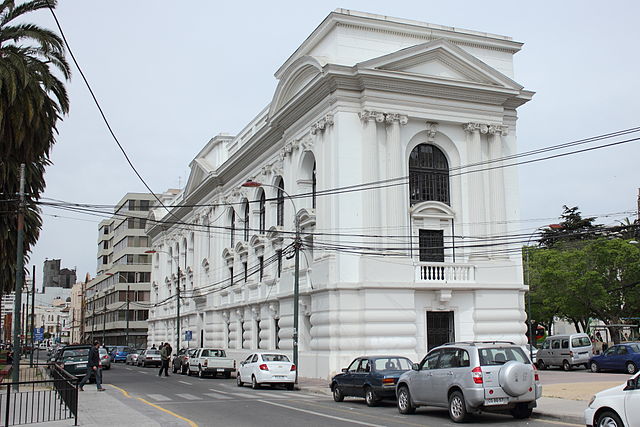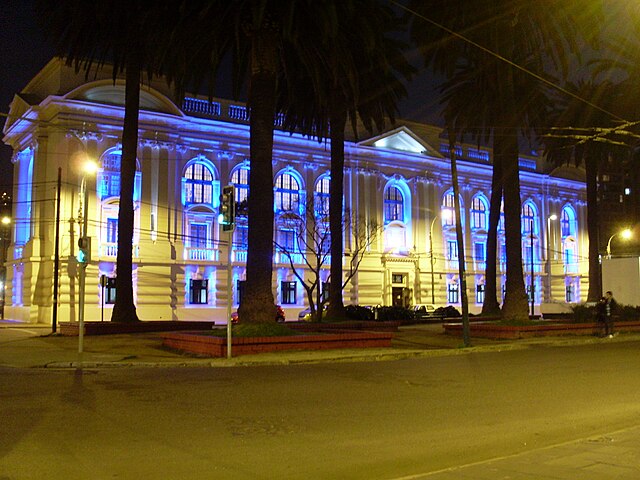Santiago Severín Library, Valparaiso, Chile
The Biblioteca Santiago Severín is a public library located in Valparaiso, Chile. It is the nation’s oldest public library, named after Santiago Severín Espina, a local businessman and philanthropist who founded the institution in the 1870s in the heart of Valparaíso, a major seaport and educational center that is Chile’s second largest city. In the 1800s European immigrants and international sailors called Valparaíso Little San Francisco and The Jewel of the Pacific. In 2003, the historic quarter of Valparaíso was named a UNESCO World Heritage Site. Valparaíso has four large universities and several vocational colleges. The library owns around 120,000 books, magazines, and newspapers, housed in a building completed in 1919. It was declared a national monument in 1998. Although the Biblioteca Santiago Severín was damaged during the major 2010 Chile earthquake, it was later restored. Even before then, a March 1985 earthquake damaged the building’s foundations, requiring extensive repairs before the library could be reopened in 1989. According to an article published in 2013 to celebrate the library’s 140th anniversary, it took eight months to restore the library to something like its condition before the earthquake. The building’s roof, façade, and the third floor were especially damaged and remained closed even after the rest of the library reopened after reconstruction. The neoclassical Renaissance style building itself occupies a full city block in Valparaiso, called by architecture critics an island-building. It was designed by the architects Arnaldo Barison Desman and Renato Schiavon, working with the engineer Augusto Geiger. Its longest façade covers 73 meters, while its narrowest is only 12 meters, making it look like a ship anchored in the middle of a map. One of its major research collections is located in a Dante Alighieri Room, named in honor of the famed Italian poet. The materials were donated in 1921 by Italian residents of Valparaíso, proud of their heritage. Other highlights of the collection include old and rare examples of travel literature and poetry. The library’s director since 2012 is Mr. Carlos Carroza Sandaño, a philosopher who is actively pursuing a policy of conserving and digitizing the collection. Old and fragile newspapers and magazines are digitized as a matter of priority, with the library applying for funds from Harvard University, Ibero-American Cooperation’s program of assistance to the development of Ibero-American archives (ADAI), and the Mapfre Foundation, to cover the expenses of this initiative. Community outreach is also an important feature of Mr. Carroza’s development plans for the library, establishing sites where the public can borrow books on beaches and by the seashore. He has also worked out a plan to establishing a reading point at a cultural park located in the hills of Valparaiso, the site of a former prison built in the early 1800s. Mr. Carroza told the journalist Germán Gautier in 2013:
We want to highlight the spirit of a public library and that is why we aspire to be an active center in the region.
Mr. Carozza is carrying on in the tradition of previous directors of the library, such as Yolanda Soto Vergara, who was in charge from 1976 to 2006, launching a digitizing program and expanding the library’s scope to include cultural programs, film series, or meetings of residents wishing to discuss ideas of the day. In 2013, Mr. Carozza told the journalists Víctor Mandujano and Catalina Mena that the spirit of a public library is important to preserve:
We aspire to be an active center and connected with citizenship.
An active program of lectures, movie screenings, art shows, concerts, book launches and other activities attracts the public. While widely appreciated, the library naturally must face issues involved with its urban location. In 2014, a news article reported that vandals had painted graffiti on the façade of the building. The library issued a statement:
We publicly declare our rejection of the markings which our building has been subjected to, not only because it is a National Monument, but that such actions do not contribute to a harmonious city for the inhabitants. We consider that the art of street graffiti must be expressed under conditions that allow its artistic and conceptual appreciation, which is far from the expression “tag” that supports a subculture that has as its purpose only to leave signatures in the buildings, dirtying the city. We hope that the people of Valparaíso help us look after the emblematic building, which today, more than ever, belongs to us all.
Sincerely yours,
Carlos Carroza Sandaño
Director

Thailand and Chile
In November, it was reported that Times Higher Education had noted that Thailand and Chile, along with some other nations, had the potential to become home to world-class universities in the future. This is because demographically, Thailand and Chile have a higher average proportion of university-aged students enrolled in higher education than a group of other nations, including Russia, India, and China. Apart from sheer numbers of students seeking higher education, Thailand and Chile also share an ambition to excel in international scholarship. From 2011 to 2015 Thailand’s research output grew by 11 per cent, with a field-weighted citation impact of 0.94, while Chile’s publication output rose by 36 per cent between those years.
Cultural exchanges.
In July The Bangkok Post celebrated Patchara Poonsawat, 28, who studied at the University of the Americas in Chile and then competed in cooking and singing competitions on television in Chile. A veteran of Thailand’s Academy Fantasia TV show, where she was briefly seen ten years ago, Patchara resurfaced last year on the MasterChef Chile and The Voice Chile programs. Her YouTube renditions of songs in English and also in Spanish have attracted a local Chilean audience. In other artistic exchanges, in July at the Bangkok Art and Culture Centre (BACC) there was a screening curated by the Thai director Apichatpong Weerasethakul of the 2012 Chilean film No, starring the Mexican actor Gael García Bernal. The story is set in Chile in the late 1980s, when the Chilean public voted about whether the dictator Augusto Pinochet should remain in power. While the film received a nomination for Best Foreign Language Film at the Oscars, in Chile it was criticized by some experts as oversimplified and mainly concerned with television advertising campaigns about the vote, focusing on marketing instead of social ethics.
(All images courtesy of Wikimedia Commons and The Biblioteca Santiago Severín)


